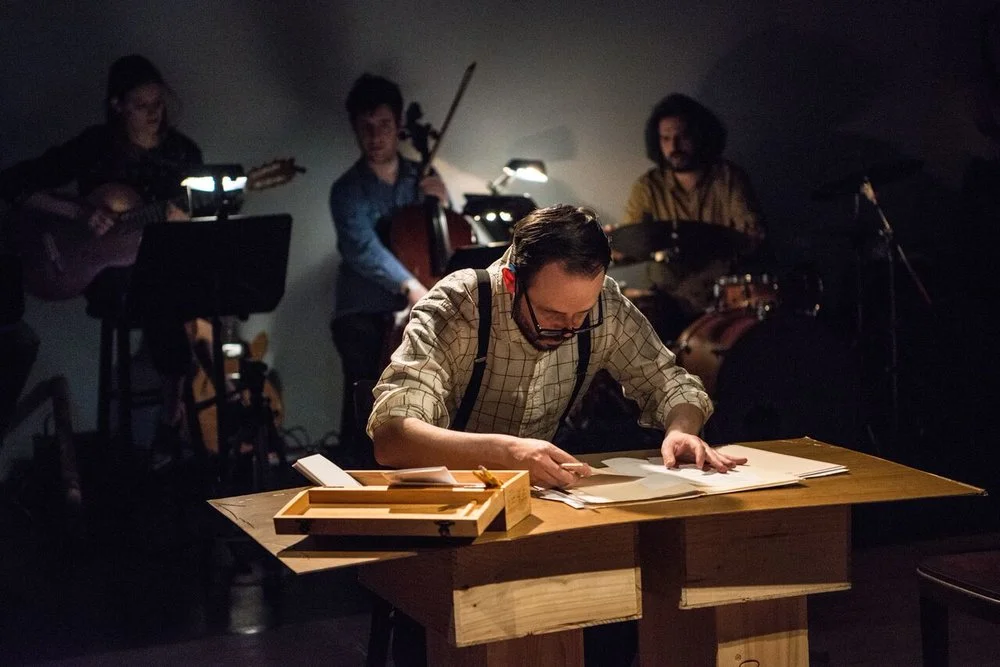Azul Otra Vez (Blue, Revisited)
Theater is a uniquely collaborative art form, uniting the widely disparate talents and focuses of often dozens of individuals to create one fully realized spectacle for the audience. It can often feel like the various contributors – actors, technicians, designers, writers, choreographers – are speaking different languages. But what if we took that idea a step further? Really leaned into it?
Azul Otra Vez (Blue, Revisited) is “part musical, part adaption, part play with music surrounding Ruben Dario’s life and work. The piece combines the author’s fictional characters and biographical elements into one tale about a poet in turn of the century Latin America struggling to make his art and his identity in a post-industrial world: a time of cultural change, immigration and economic fluctuation, not dissimilar to the one we are living today.” The book, by Melís Aker, is in English, while the lyrics, by Jacinta Clusellas (sometimes adapted from Dario), are in Spanish (with simultaneous English translation). The music, a jazz and folklore fusion, serve as a third language of sorts.
I spoke with Tatiana Pandiani, a co-creator and the piece’s director, soon after a recent showing of Act I of Azul at BRIC.
What do you mean by "bilingual theater?" Would you say theater is an
inherently bilingual/multilingual artform?
In this particular case we were working with a book in English and lyrics in Spanish. Since we were working with Ruben Dario's original poetry we didn't feel like translating his words would be "good enough." Poetry can get lost or ruined in translation and we wanted to find a way to keep the original poetry as Spanish lyrics.
In musical theater in particular, we are already asking an audience to understand and pick up two languages – the spoken word and the sung word. So if you think about it musicals are already multilingual.
What inspired you to explore the multilingual experience in this way?
We are always trying to find ways in which we can open the doors of our work to audiences that are monolingual - whether that be English or Spanish - or bilingual/multilingual. The US and New York in particular have been multilingual since who knows when and that is definitely still the case. So many people in New York live bilingual lives so why not make theater that reflects that experience? There is an unexamined assumption that the theater must be in English so the “majority” of people can access it, and we would like to defy that.
Language also contains culture; there are things that cannot be translated, and we hope that by allowing some of the material to remain in its original Spanish we will allow audiences to access the cultural and historical elements of the piece in a more direct way.
Do you think theater is especially well suited to this form of storytelling?
I believe that if the storytelling can in some way avoid the alienating process of translation, the story will be told in a more compelling way. In addition, allowing actors to perform in their native language allows audiences to access them, their identity and their personal and cultural backgrounds without filters. Latinx performers are so used to telling their stories through translation or adaptation to a non latinx audience... so much of theater performance is about discovering another person or another group of people, so we believe it's suited to have them speak in their native tongue
Why the story of Ruben Dario? And why did it need to be told this way? When
did music become part of the project?
Music was always part of the project. We actually begin with a conceptual album by
Jacinta and developed the story from that starting point. We believe that Dario's characters are very much connected to our contemporary moment. He is also writing from a time of economic shifts and cultural change, a time of immigration, a time where social and financial structures were changing. The 1890s were this transitional moment for America and we felt like it was so similar to what we're going through today.
What are your own stories of coming here? How have your experiences shaped your art? How have they shaped this project in particular?
My family's history is very connected to the kind of work that I do. I was born in Argentina and left as a young infant so a lot of the work I'm interested in doing has to do with leaving home and creating a new home far away from the place that we come from. And of course in New York lots of people can connect to that, whether because they left their geographic home or feel somehow separate from their families or the environment in which they grew up.
Living a nomadic life with my family has informed my curiosity for new places and new people. And in Dario’s stories we see this traveling poet who is also looking to create a new home, so that was an easy connect for me.
I find that music and dance are primary ingredients in my work and I tend to think that this is because they can contain culture in spite of distance. Music, dance and movement are shortcuts to who we are and how we are with other people so incorporating them into the work has proven to be very fruitful and bringing people together, both on and off stage
Photography: Federica Borlenghi








